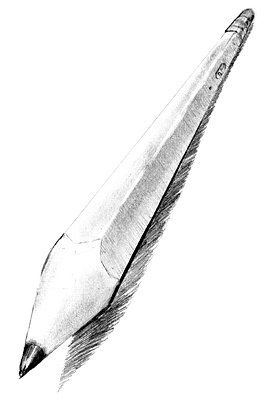All Nonfiction
- Bullying
- Books
- Academic
- Author Interviews
- Celebrity interviews
- College Articles
- College Essays
- Educator of the Year
- Heroes
- Interviews
- Memoir
- Personal Experience
- Sports
- Travel & Culture
All Opinions
- Bullying
- Current Events / Politics
- Discrimination
- Drugs / Alcohol / Smoking
- Entertainment / Celebrities
- Environment
- Love / Relationships
- Movies / Music / TV
- Pop Culture / Trends
- School / College
- Social Issues / Civics
- Spirituality / Religion
- Sports / Hobbies
All Hot Topics
- Bullying
- Community Service
- Environment
- Health
- Letters to the Editor
- Pride & Prejudice
- What Matters
- Back
Summer Guide
- Program Links
- Program Reviews
- Back
College Guide
- College Links
- College Reviews
- College Essays
- College Articles
- Back
A Pencil
Most people are entranced by diamonds: so reflective and beautiful, so hard and seemingly indestructible; something so romantic and exotic made of an element considered so ordinary. I, however, much prefer to admire a different allotrope of carbon: graphite. There is beauty in its structure, layer upon layer of carbon atoms, each holding itself together with incredibly strong bonds—even stronger than those in diamonds—but so easily pulled apart.
I own quite a bit of graphite. Graphite pencils and sticks of lead are hidden all over my room, like eggs on Easter morning. I own a grayscale rainbow, from mechanical pencils I use for writing to wooden ones ranging from 6H to 8B, scattered among my vast collection of waxy colors. My rainbow, however, means far more to me than any number of hastily dyed eggs.
I am fascinated by graphite’s ability to peel apart, leaving shadows of itself on everything it touches. It reminds me of the human mind—or perhaps simply my own. Pencils are a medium for my thoughts, a pathway through which I can pour myself. Like the graphite, with every swipe of my pencil, a piece of my mind—a thought, an image, an emotion—peels away onto the paper beneath my fingers. Each mark of my pencil is a shadow of my mind, pressed into existence.
A pencil is truly remarkable; it can make the most abstract and intangible of concepts clear and concrete and can share the insulated world of my mind with others. Armed with a pencil, I am a fearless warrior, an artist with nerves of steel, a confident scientist and mathematician. With a pencil in hand, my thoughts and emotions, my creativity and ingenuity, pour onto paper like water, as if my thoughts were the streams that pour from my fingertips in the shower, uncontrollable and free.
But more than simply allowing themselves to be used, pencils have taught me about potential passions and even about myself. As soon as my chubby baby fingers could pick up a pencil, I learned the joys of art and creation. Storytelling became a passion of mine, as I peeled away Post-It note after Post-It note, covering hundreds with the scribbles of a toddler with no knowledge of written letters, yet the dreams of a writer. As I grew older, the scribbles turned into letters and faces, words and pictures. Though now lost, the first story I remember writing filled page after page of a large notepad, a tale of a princess in her castle, complete with illustrations. I can just barely remember the sketch of a princess, filling half of a page, her bubblegum pink dress ballooning from her waist. Art became a constant presence, from sketches in the margins of notes and on stolen sheets of printer paper to the countless short stories and novel concepts I drew up. I have kept many of my old notebooks, filled with stories and characters, and my sketchbooks, worn to near disintegration by constant use, pages covered in smudged, faded sketches. By the time I was eleven years old, without a pencil at hand, I felt naked, and as if I were missing a part of myself, as if a finger had suddenly gone missing.
Even now, I still feel the ache to hold a pencil, to scribble my thoughts onto paper. The possibilities are endless: shall I draw up a new character or an old favorite? Or shall I work my way through the calculus of simple harmonic motion? I could design a costume, work out for myself lessons on thermochemistry, jot down ideas for a new novel, or even list my plans for the future or my reasons for despising Sigmund Freud. It is rare to find my hand not curled around a pencil, furiously attempting to keep up with the flurry of thoughts pouring from my mind.
Holding a pencil is a magical experience. It is as if, upon taking the pencil between my fingers, that all the floodgates of my mind burst, and all sorts of thoughts and ideas make themselves known. It is hard for me to think without a pencil at hand. I can spend an eternity trying fruitlessly to think of a new art concept, or to work out a math problem, or to understand or elaborate on a scientific idea, but once a pencil is curled safely in my fist, my mind is set free, as if the pencil could break down the wall of self-consciousness and doubt.
I have grown up with a pencil in my hand. Pencils have shaped me into the person I am today—the artist, the writer, the scientist, the thinker—while allowing me a method of expression with no bounds. Pencils have been an integral part of my life—from my latest sketches and equations to my first drawing of a mermaid to the shaky tracings of Spanish words. They represent my passions, my ambitions, and my sense of self.
Y entonces, yo soy yo y mi lápiz: I am myself and my pencil.

Similar Articles
JOIN THE DISCUSSION
This article has 0 comments.
